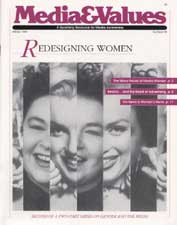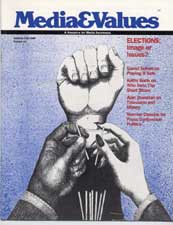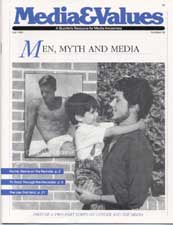The Bribed Soul: Ads, TV and American Culture
|
Article Images:
Citation: From the introduction to the author's best-selling book, The Sponsored Life. Posted with permission of the author. |
How advertising transforms both our experience and identity into a "sponsored life."
Television-watching Americans — that is, just about all Americans — see approximately 100 TV commercials a day. In that same 24 hours they also see a host of print ads, billboard signs, and other corporate messages slapped onto every available surface, from the fuselages of NASA rockets right down to the bottom of golf holes and the inside doors of restroom stalls. Studies estimate that, counting all the logos, labels and announcements, some 16,000 ads flicker across an individual's consciousness daily.
Advertising now infects just about every organ of society, and wherever advertising gains a foothold it tends to slowly take over, like a vampire or a virus. When television broadcasting began about 50 years ago, the idea of network that would air nothing but commercials was never seriously considered, not even when single-sponsor shows were produced straight out of the sponsor's ad agency.
But today, by the grace of cable, we have several such channels, including MTV and FYI, a proposed new channel that would run only ads. Similarly, product placement in the movies started small, with occasional Tab showing up in a star's hand, but now it's grown big enough to eat the whole thing. In its 1993 futuristic thriller Demolition Man, Warner Bros. not only scattered the usual corporate logos throughout the sets but also rewrote the script so that the only fast-food chain to survive the "franchise wars" of the 20th century was Taco Bell — which, in return, promoted the movie in all its outlets.
From the cradle to the rocking chair, American life marches to the steady beat of commercialism.
Even older, far statelier cultural institutions have had their original values hollowed out and replaced by ad values, leaving behind the merest fossil of their founders' purpose. Modernist masters enjoy art museum blockbusters only when they can be prominently underwritten by an oil company or telecommunications giant; new magazines are conceived, not on the basis of their editorial content but on their ability to identify potential advertiser and groom their copy to fit marketing needs.
As for all those television-watching Americans, hit on by those 16,000 paid (and tax-deductible) messages a day, they're even more vulnerable than their institutions. Most admakers understand that in order to sell to you they have to know your desires and dreams better than you may know them yourself, and they've tried to reduce that understanding to a science.
Market research, in which psychologists, polling organizations, trends analysts, focus group leaders, "mall-intercept" interviewers, and the whole panoply of mass communications try to figure out what will make you buy, has become a $2.5 billion annual business growing at a healthy clip of about 4.2 percent a year (after adjustment for inflation).
Yet even this sophisticated program for the study of the individual consumer is only a starter kit for the technological advances that will sweep through the advertising-industrial complex in the 1990s. Today, the most we can do when another TV commercial comes on — and we are repeatedly told that this is our great freedom — is to switch channels. But soon technology will take even that tiny tantrum of resistance and make it "interactive," providing advertisers with information on the exact moment we became bored — vital data that can be crunched, analyzed, and processed into the next set of ads, the better to zap-proof them.
Impressive as such research may be, the real master work of advertising is the way it uses the techniques of art to seduce the human soul. Virtually all of modern experience now has a sponsor, or at least a sponsored accessory, and there is no human emotion or concern — love, lust, war, childhood innocence, social rebellion, spiritual enlightenment, even disgust with advertising — that cannot be reworked into a sales pitch. The transcendent look in a bride's eyes the moment before she kisses her groom turns into a promo for Du Pont. The teeth gnashing humiliation of an office rival becomes an inducement to switch to AT&T.
In short, we're living the sponsored life. From Huggies to Maalox, the necessities and little luxuries of an American's passage through this world are provided and promoted by one advertiser or another. The sponsored life is born when commercial culture sells our own experiences back to us. It grows as those experiences are then reconstituted inside us, mixing the most intimate processes of individual thought with commercial values, rhythms, and expectations.
There is no human emotion or concern — love, lust, war, childhood innocence, social rebellion, spiritual enlightenment, even disgust with advertising — that cannot be reworked into a sales pitch.
It has often been said by television's critics that TV doesn't deliver products to viewers but that viewers themselves are the real product, one that TV delivers to its advertisers. True, but the symbiotic relationship between advertising and audience goes deeper than that. The viewer who lives the sponsored life — and this is most of us to one degree or the other — is slowly re-created in the ad's image.
Inside each "consumer," advertising's all-you-can-eat, all-the-time, all-dessert buffet produces a build-up of mass-produced stimuli, all hissing and sputtering to get out. Sometimes they burst out as sponsored speech, as when we talk in the cadences of sitcom one-liners, imitate Letterman, laugh uproariously at lines like "I've fallen and I can't get up," or mouth the words of familiar commercials, like the entranced high school student I meet in a communications class who moved his lips with the voiceover of a Toyota spot.
Sometimes they slip out as sponsored dress, as when white suburban kids don the baggy pants and backward baseball caps they see on MTV rappers. Sometimes they simply come out as sponsor equations, as when we attribute "purity" and "honesty" to clear products like Crystal Pepsi or Ban's clear deodorant.
To lead the sponsored life you don't really have to do anything. You don't need to have a corporate sponsor as the museums or the movies do. You don't even have to buy anything — though it helps, and you will. You just have to live in America and share with the nation, or at least with your mall-intercept cohorts, certain paid-for expectations and values, rhythms and reflexes.
The chief expectation of the sponsored life is that there will and always should be regular blips of excitement and resolution, the frequency of which is determined by money. We begin to pulse to the beat, the one-two beat, that moves most ads: problem/solution, old/new, BrandX/Hero brand, desire/gratification.
In order to dance to the rhythm, we adjust other expectations a little here, a little there: our notions of what's desirable behavior, our lust for novelty, even our vision of the perfect love affair or thrilling adventure adapt to the mass consensus coaxed out by marketing. Cultural forms that don't fit these patterns tend to fade away, and eventually everything in commercial culture comes to share the same insipid insistence on canned excitement and neat resolution.
What's all the excitement about? Anything and nothing. You know you've entered the commercial zone when the excitement building in you is oddly incommensurate with the content dangled before you…through the sympathetic magic of materialism we learn how to respond to excitement: It's less important that we purchase any particular product than that we come to expect resolution in the form of something buyable.
Commercials are the tinny jingles in our heads that remind us of all we've abandoned in exchange for our materially comfortable lives — real extended families, real human empathy, real rebel prowess.








 But Schwartz, a rather soft-spoken man with a teddy-bear-like persona, is far more than just a commercial-maker. He is also a fervent believer in grass-roots media activism. The same media reality that is used to push presidential candidates and billion-dollar companies can be used by average citizens to get results where they live, he maintains. And if you use local radio – his favorite medium – it costs far less than you might imagine and can be far more effective than you think.
But Schwartz, a rather soft-spoken man with a teddy-bear-like persona, is far more than just a commercial-maker. He is also a fervent believer in grass-roots media activism. The same media reality that is used to push presidential candidates and billion-dollar companies can be used by average citizens to get results where they live, he maintains. And if you use local radio – his favorite medium – it costs far less than you might imagine and can be far more effective than you think.
